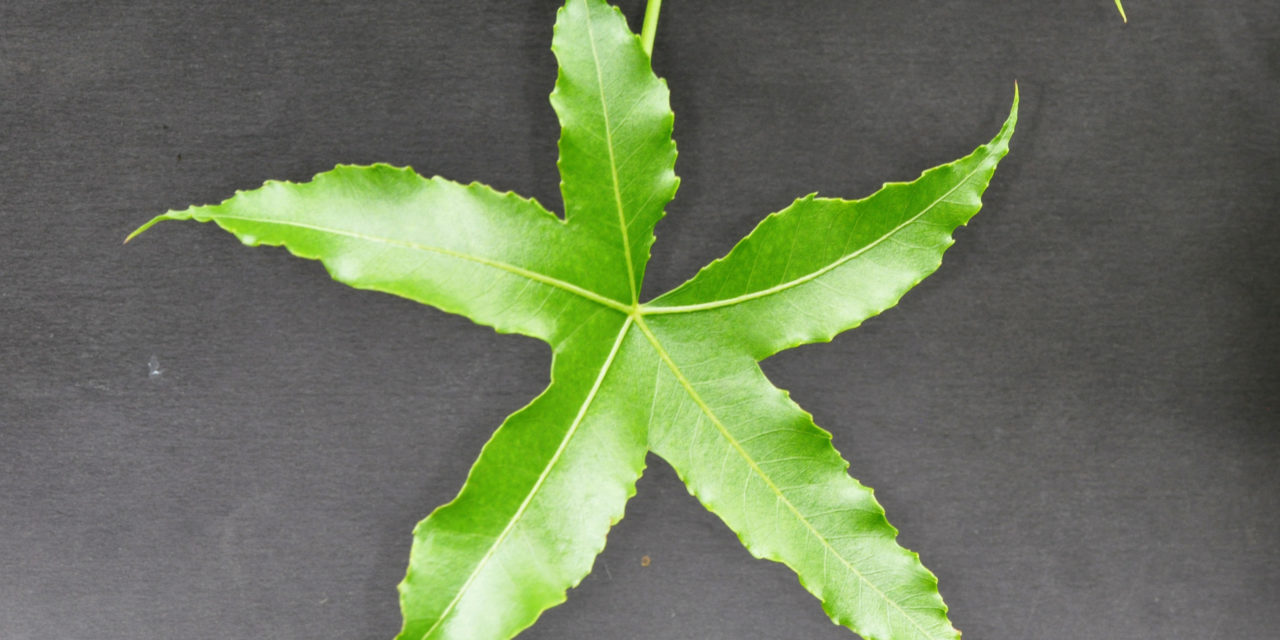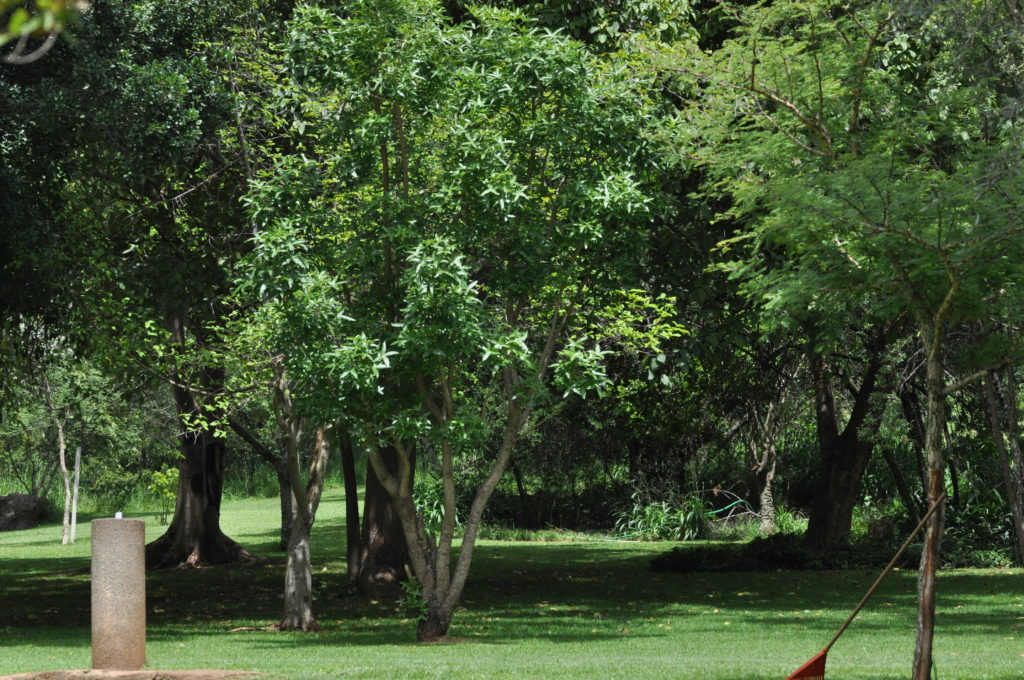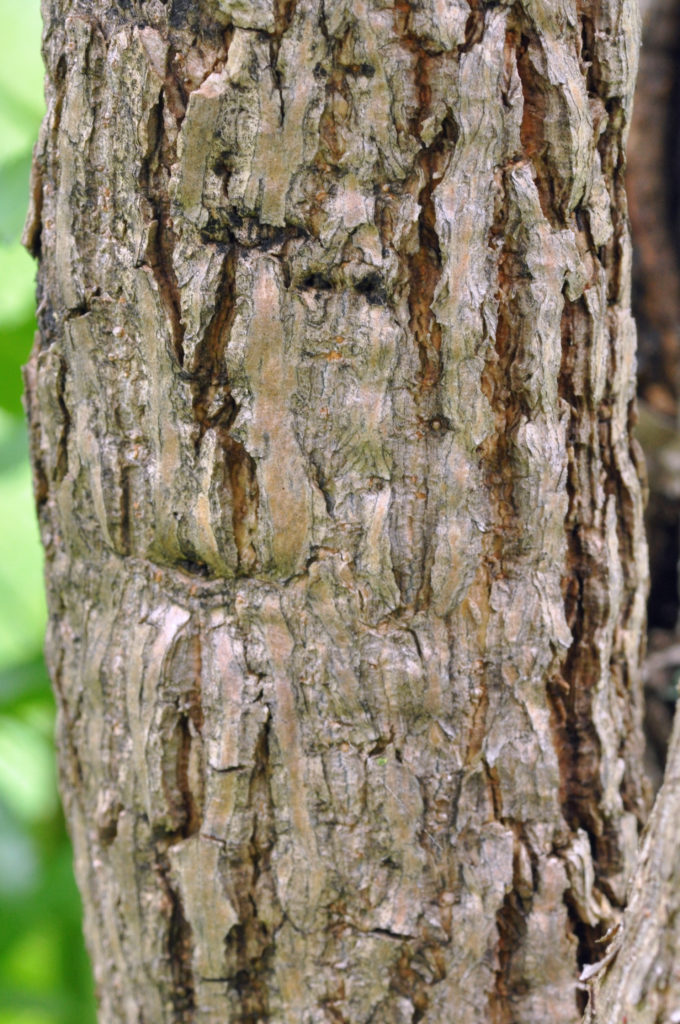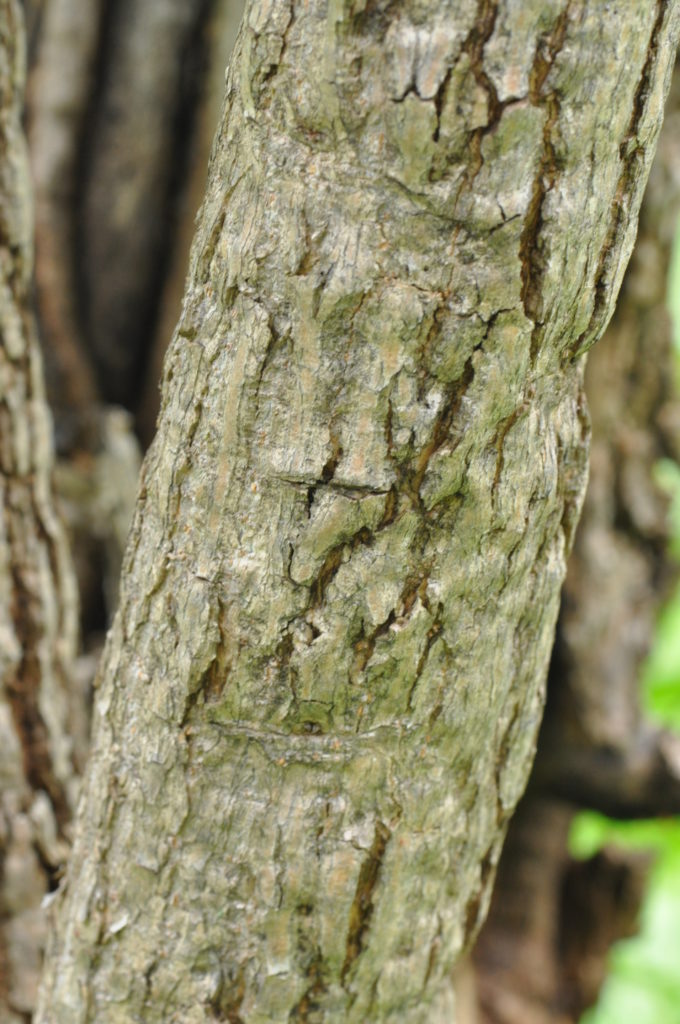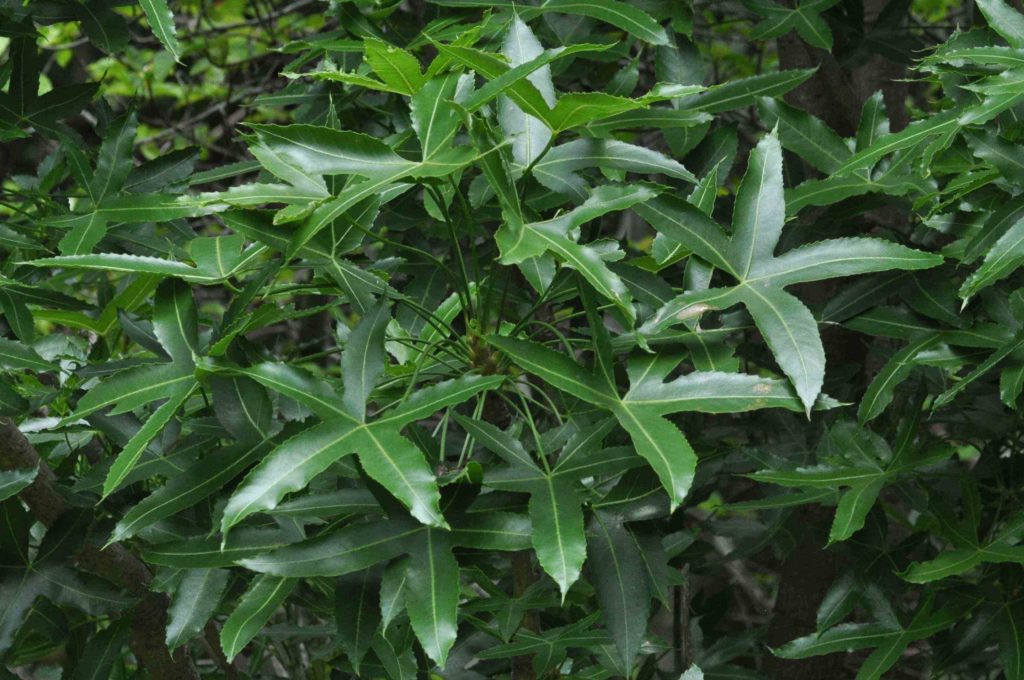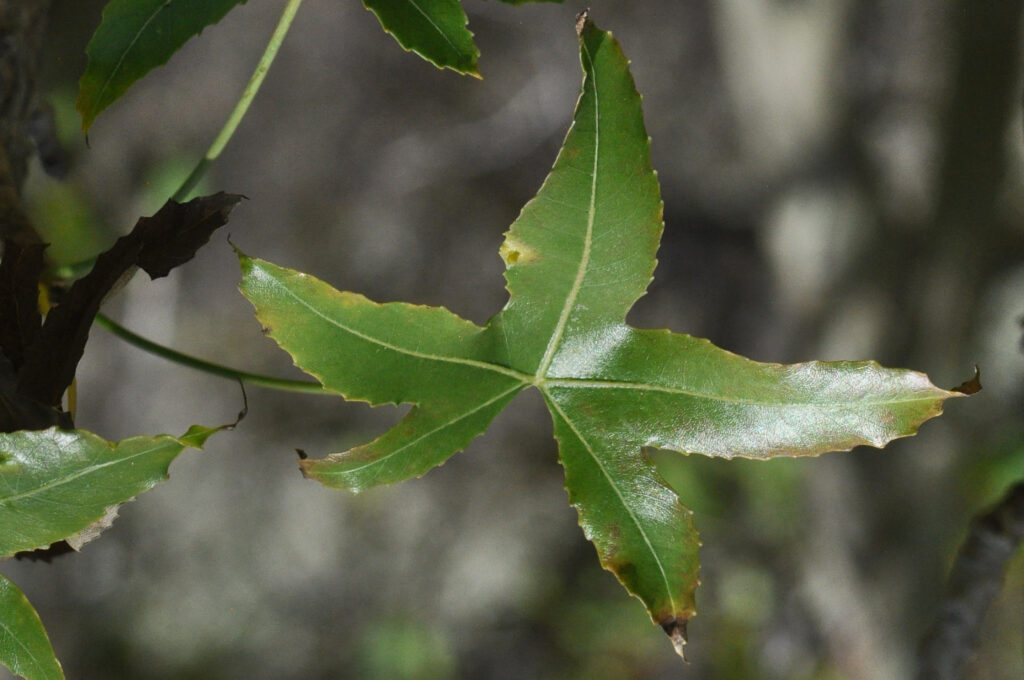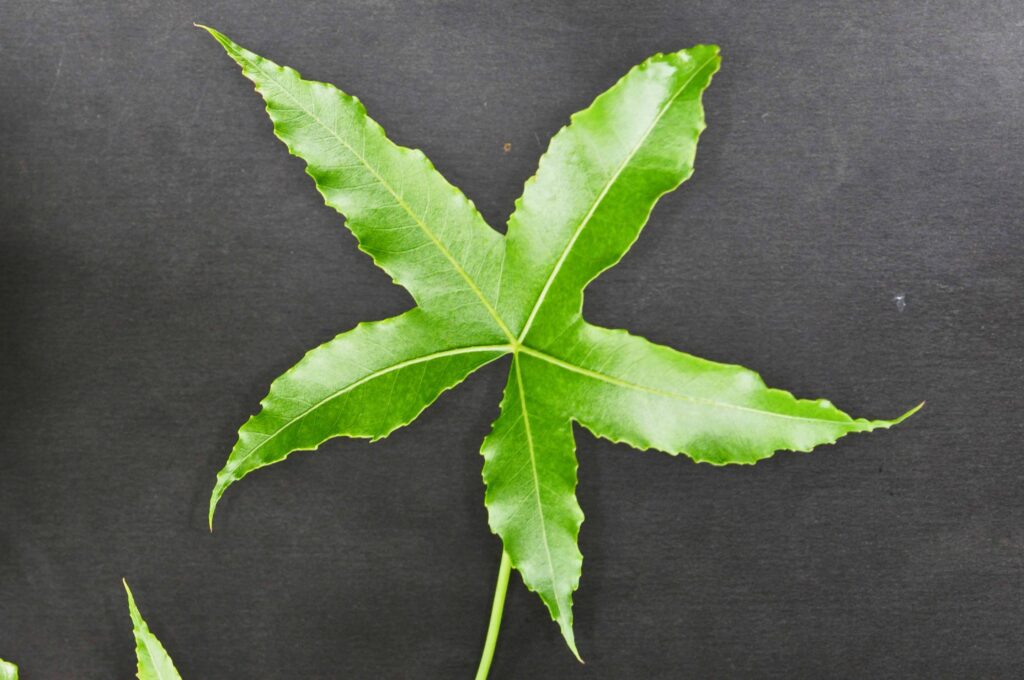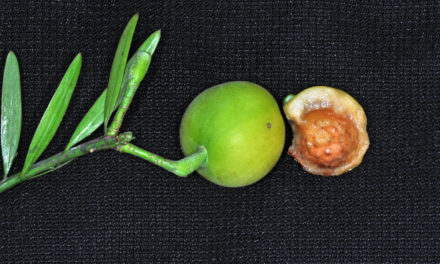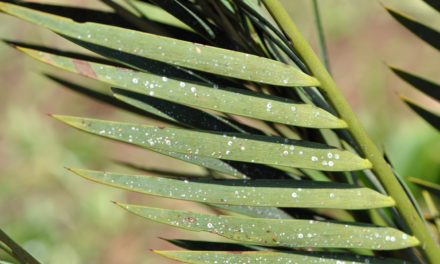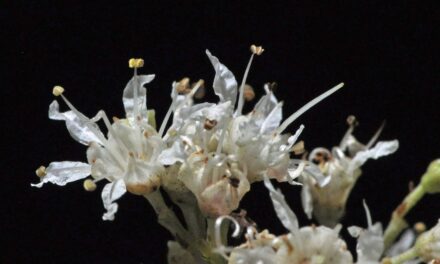General Info – summary
This much-branched monoecious Tree is up to 6m+ high and 0,6m wide. The deeply fissured bark is corky. The palmate, simple Leaves have 3 to 5 deep lobes with conspicuous midribs and irregularly toothed margins. Greenish yellow, 5-merous Flowers are in spikes at branch ends. The inferior ovary has 2 locules and 2 styles. The small, mature Fruit is purplish, indehiscent drupe that is glabrous and fleshy.
Description
SA Tree No. 562.
Common names: (Afr) Kiepersolboom, Nooiensboom, Nooisboom, Oumeidboud, Rotskiepersol, Sambreelboom. (Eng) Cabbage Tree, Natal Cabbage Palm, Natal Cabbage Tree, Rock Cabbage-tree, Simple-leaved Cabbage-tree. (isiZulu) Umgezisa, Umsenge. (Tshivenda) Musenzhe-thavha.
Family Araliaceae: (Ivy and cabbage-tree family). The family includes trees, shrubs, vines and herbs. The mainly woody species are of tropical distribution. In southern Africa, there are 5 genera and about 18 species. Those genera with trees on this website include Cussonia and Schefflera. Leaves are usually alternate. They may also be once or twice digitally compound. 1-3 bracts that persist around the fruit and subtend the regular, bisexual or unisexual Flowers. In Cussonia the flowers are in spikes or racemes and in Schefflera flowers are umbels, in panicles. The Calyx is often reduced. There are usually as many Stamens as Petals. Anthers are ovate or oblong with 2 pollen sacs. The usually 5 petals are attached to the inferior, 2-locular Ovary. Each locule has a single ovule. Styles equal the number of locules. The often-fleshy Fruit is usually a drupe or berry. It may split into individual carpel units, called mericarps, with 1 or more seeds.
Name derivation: The name Cussonia was given by Carl Peter Thunberg to commemorate the French botanist Pierre Cusson (1727-1783). He was professor of Botany at the University of Montpellier in France. He specialised in the Apiaceae or Umbellifera. natalensis – from the now Kwazulu-Natal. There are about 25 species in the genus Cussonia. Of these about 10 occur in the southern Africa.
Conservation: National Status: L C. (Least Concern). Assessed: 2018/11/07. (L. von Staden).
Tree
This thickset, small to medium sized Tree (photo 759) is much branched with a rounded spreading crown and may reach from 5 to 10m high. The much branched Trunk is sturdy and up to 0,6m in diameter. Branches are spreading. The corky Bark is deeply longitudinally fissured, with rectangular cracks (photos 542 & 543).
- 759. 2020/01/20. Walter Sisulu NBG. Photo: David Becking.
- 542. 2014/12/09 Walter Sisulu NBG. Photo: David Becking.
- 543. 2014/12/09. Walter Sisulu NBG. Photo: David Becking.
Leaves
This deciduous tree has hairless, shiny Leaves that are up to 15cm wide and relatively simple (have a single blade which may have incisions that are not deep enough to divide the blade into leaflets). This is distinctive. However, the incisions extend quite a way, giving rise to the star shaped leaf (photo 544). These leaves are clearly visible in the photo 516. The leaves are deeply 3-5 palmately lobed (lobed or divided or ribbed in a palm-like or hand-like fashion) but not completely divided (photo 544). When 5-lobed, the upper 3 lobes are slightly larger (photo 516). The lanceolate lobes are narrow. The thin Petiole (leaf stalk) is – up to 30cm long. Stipules (basal appendage of the petiole) are adnate (fusion of unlike parts – here the stipule and petiole). Leaves are crowded on long petioles at the ends of knobbly short branches. Young leaves are brownish green. Before falling in autumn, the glossy green, leaves (photo 516) turn yellow. The Midrib in each lobe is conspicuous on both sides. Other veins are clearer below. Each leaf is up to 20cm wide. This and the palmate, simple leaves makes this Cussonia one of the easiest to identify. The bluntly and irregularly toothed Margin may be wavy. The Apex is attenuate (showing a long gradual taper towards the apex). The Base is broadly obtuse to cordate (heart shaped).
- 760. 2020/01/20 Walter Sisulu NBG. Photo:David Becking.
- 516. 2019/09/04. Walter Sisulu NBG. Photo: David Becking.
- 544. 2014/12/09 Walter Sisulu NBG. Photo: David Becking.
Flowers
The regular, greenish-yellow and unpleasantly scented (for us) Flowers are grouped in up to 12 terminal heads of radiating cylindrical Spikes (simple indeterminate inflorescences with each sessile flower on a single unbranched pedicle – flower stalk). Each spike is up to 15cm long and emerges from thickened side shoots that radiate from the ends of a branch. The flowers are 5-merous. The Calyx has 5 toothed and almost entire Sepal lobes that occur above the ovary. Each flower has 5 Petals in the corolla that are valvate (meeting at the edge without overlapping). The 5 Stamens have ovate Anthers that are slightly shorter than their Filaments. Each anther has 2 Thecae (pollen sacs which produce microspores –pollen grains). The inferior Ovary has 2 locules and 2 styles. (Feb-May).
Fruit
The small, fleshy and nearly spherical Fruit is a tiny, about 5mm wide, indehiscent Drupe or stone fruit. It is a fleshy fruit with the seed enclosed in a stony Endocarp – like a tiny peach. Beyond this is a fleshy Mesocarp surrounded by the skin or Exocarp. Each fruit is glabrous (smooth and hairless). When mature, the fruits are purplish and remain crowded on the spikes at the end of branches. Seeds are almost spherical to oblong. (Jun-Dec).
Distribution & Ecology
This frost sensitive Tree is Endemic (endemism is the ecological state of a species being unique to a defined geographic location) in southern Africa. It is found on rocky hills, in bushveld – usually away from the coast, at an altitude between 1 400m and 1 700m. It thrives in hot, dry areas. In South Africa, these trees are located in KwaZulu-Natal, Mpumalanga and Limpopo. They are also located in Swaziland, Zimbabwe and Mozambique. Local medicine makes use of the leaves.
Ethnobotany
The Wood is used for making dishes, bowls and cups. Trees are decorative and easily cultivated but frost sensitive. There is one report of aggressive roots. A pentacyclic triterpene acid, with anti-ulcer properties has been extracted from Cussonia natalensis.
References
Boon, R. 2010. Pooley’s Trees of eastern South Africa. Flora and Fauna Publications Trust, Durban.
Burrows, J.E., Burrows, S.M., Lotter, M.C. & Schmidt, E. 2018. Trees and Shrubs Mozambique. Publishing Print Matters (Pty) Ltd. Noordhoek, Cape Town.
Coates Palgrave, M. 2002. Keith Coates Palgrave Trees of Southern Africa. edn 3. Struik, Cape Town.
Lawrence, G. H. M, 1951. Taxonomy of Vascular Plants. The Macmillan Company, New York. Tenth Printing 1965.
Palmer, E. & Pitman, N. 1972. Trees of southern Africa. Balkema, Amsterdam, Cape Town.
Schmidt, S. Lotter, M. & McCleland, W. 2002. Trees and Shrubs of Mpumalanga and the Kruger National Park. Jacana, Johannesburg.
van Wyk, B. & van Wyk, P. 1997 Field guide to Trees of Southern Africa. Struik, Cape Town.
von Staden, L. 2018. Cussonia natalensis Sond. National Assessment: Red List of South African Plants version . Accessed on 2024/08/25.
http://www.zimbabweflora.co.zw/speciesdata/species.php?species_id=142920
https://www.researchgate.net/publication/256829696_A_pentacyclic_triterpene_acid_with_anti-ulcer_properties_from_Cussonia_natalensis
https://ujdigispace.uj.ac.za/handle/10210/8059
http://posa.sanbi.org/flora/browse.php?src=SP

